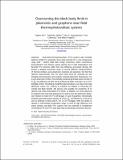| dc.contributor.author | Ilic, Ognjen | |
| dc.contributor.author | Jablan, Marinko | |
| dc.contributor.author | Soljacic, Marin | |
| dc.contributor.author | Joannopoulos, John | |
| dc.contributor.author | Celanovic, Ivan L. | |
| dc.date.accessioned | 2013-01-25T17:33:16Z | |
| dc.date.available | 2013-01-25T17:33:16Z | |
| dc.date.issued | 2012-03 | |
| dc.date.submitted | 2012-03 | |
| dc.identifier.issn | 1094-4087 | |
| dc.identifier.uri | http://hdl.handle.net/1721.1/76607 | |
| dc.description.abstract | Near-field thermophotovoltaic (TPV) systems with carefully tailored emitter-PV properties show large promise for a new temperature range (600 – 1200K) solid state energy conversion, where conventional thermoelectric (TE) devices cannot operate due to high temperatures and far-field TPV schemes suffer from low efficiency and power density. We present a detailed theoretical study of several different implementations of thermal emitters using plasmonic materials and graphene. We find that optimal improvements over the black body limit are achieved for low bandgap semiconductors and properly matched plasmonic frequencies. For a pure plasmonic emitter, theoretically predicted generated power density of 14[W over cm[superscript 2]] and efficiency of 36% can be achieved at 600K (hot-side), for 0.17eV bandgap (InSb). Developing insightful approximations, we argue that large plasmonic losses can, contrary to intuition, be helpful in enhancing the overall near-field transfer. We discuss and quantify the properties of an optimal near-field photovoltaic (PV) diode. In addition, we study plasmons in graphene and show that doping can be used to tune the plasmonic dispersion relation to match the PV cell bangap. In case of graphene, theoretically predicted generated power density of 6(120)[W over cm[superscript 2]] and efficiency of 35(40)% can be achieved at 600(1200)K, for 0.17eV bandgap. With the ability to operate in intermediate temperature range, as well as high efficiency and power density, near-field TPV systems have the potential to complement conventional TE and TPV solid state heat-to-electricity conversion devices. | en_US |
| dc.language.iso | en_US | |
| dc.publisher | Optical Society of America | en_US |
| dc.relation.isversionof | http://dx.doi.org/10.1364/OE.20.00A366 | en_US |
| dc.rights | Article is made available in accordance with the publisher's policy and may be subject to US copyright law. Please refer to the publisher's site for terms of use. | en_US |
| dc.source | MIT web domain | en_US |
| dc.title | Overcoming the black body limit in plasmonic and graphene near-field thermophotovoltaic systems | en_US |
| dc.type | Article | en_US |
| dc.identifier.citation | Ilic, Ognjen et al. “Overcoming the Black Body Limit in Plasmonic and Graphene Near-field Thermophotovoltaic Systems.” Optics Express 20.S3 (2012): A366. © 2012 OSA | en_US |
| dc.contributor.department | Massachusetts Institute of Technology. Institute for Soldier Nanotechnologies | en_US |
| dc.contributor.department | Massachusetts Institute of Technology. Department of Physics | en_US |
| dc.contributor.mitauthor | Ilic, Ognjen | |
| dc.contributor.mitauthor | Joannopoulos, John D. | |
| dc.contributor.mitauthor | Celanovic, Ivan | |
| dc.contributor.mitauthor | Soljacic, Marin | |
| dc.relation.journal | Optics Express | en_US |
| dc.eprint.version | Final published version | en_US |
| dc.type.uri | http://purl.org/eprint/type/JournalArticle | en_US |
| eprint.status | http://purl.org/eprint/status/PeerReviewed | en_US |
| dspace.orderedauthors | Ilic, Ognjen; Jablan, Marinko; Joannopoulos, John D.; Celanovic, Ivan; Soljačić, Marin | en |
| dc.identifier.orcid | https://orcid.org/0000-0002-7184-5831 | |
| dc.identifier.orcid | https://orcid.org/0000-0002-7244-3682 | |
| dc.identifier.orcid | https://orcid.org/0000-0001-8651-7438 | |
| mit.license | PUBLISHER_POLICY | en_US |
| mit.metadata.status | Complete | |
